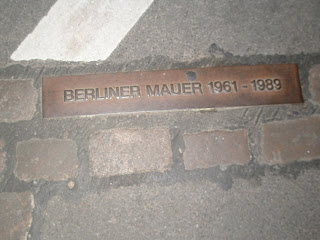
In August of 1961, the GDR (German Democratic Republic) completely closed off East Berlin from West Berlin by erecting what is today known as the Iron Curtain. The Iron Curtain doesn’t entirely refer to the Berlin wall, but more broadly refers to the separation of Eastern and Western Europe. This 103 mile-long concrete barrier had East Berliners trapped u
nder Communist rule for nearly a qua
rter of a century (http://www.dailysoft.com/ berlinwall/maps/berlinwallmap_02.htm). After years of constant struggle, world tensions and divided territory, the wall finally came down in November of 1989. This major event in world history was broadcast all over the world and symbolized the beginnings of a more unified democratic Europe.

Today, when you visit Berlin there is a distinct presence
associated with that dark time in recent history. When you walk down both main and back streets, you find plaques, fragments, and large spans of the wall that remain. One can begin to get a sense of how expansive and controlling this wall was. Just crossing the street there is a brick line that represents where the wall once stood. Reminders of the wall also exist next to major buildings, such as the Reichtag
and Brandenburg Gate, major tourists attractions of the city. It is interesting to see how the urban landscape has developed and merged over this once clearly divided city. New shops, offices, and streets are interspersed along the former path of the wall.

Most impressive, however, is the East Side Gallery. It is the largest stretch of wall that is currently intact stretching 1.8 miles parallel to the Spree River. This gallery consists of expressive, bold art that has been created from artists all over the world to visually voice about the affects of the wall and how it is
not something to soon forget (http://www.dailys oft.com/berlinwall/guide/east-side-gallery.htm). This artistic movement began in the 1980’s and still continues today. Unfortunately, many of these pieces were neglected, painted over, and ruined during the 1990s. Some of the more famous works were repainted thanks to donations and private sponsors for the East Side Gallery. I saw long spans of wall that were taken over by tourists signing their name and writing messages about the wall. Although the wall is ‘protected’, it still needs more care.

The effects of the Iron Curtain are seen all over the wall itself and the city. The West side of the wall is covered with the artistic murals which represent the unification of Europe after the wall was torn down and the East side is painted a plain grey to represent the plain, controlled lives that were existent in Eastern Berlin as well as Europe. This deep symbolism is not only graphically moving, but g
roundbreaking because this infamous site is not your typical historical monument of a churc
h, sculpture or museum rather it’s an artistic expression that is constantly changing and reminding others of the impact separation and world conflict brings.
*An interesting view of before and after pictures of Berlin can be seen in this article. Notice the buildings that have remained and the ones that have been replaced in the street facades: http://www.nytimes.com/interactive/2009/11/09/world/europe/20091109-berlinwallthennow.html
This was a really good overview of the wall, both the history and the artwork. Although it isn't the most touristy part of Berlin, I thought it had the most significance of all the places in Berlin.
ReplyDelete